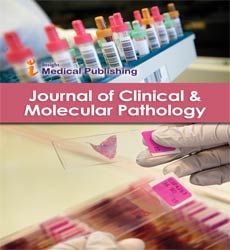ISSN : 2634-7806
Journal of Clinical and Molecular Pathology : Open Access
Report about the Course ÃÆâÃâââ¬Ãâà âPathology of Melanocytic TumorsÃÆâÃâââ¬Ãâàin New York, May 09-10th, 2016
Udo Hennighausen*
Private Practice for Ophthalmology, Germany
- *Corresponding Author:
- Dr. Udo Hennighausen
Private Practice for Ophthalmology, Markt 9, D 25746 Heide, Germany
Tel: +494812621
E-mail: Udo.Hennighausen@web.de
Received date: February 25, 2017; Accepted date: March 29, 2017; Published date: April 06, 2017
Citation: Hennighausen U (2017) Report about the Course “Pathology of Melanocytic Tumors” in New York, May 09-10th, 2016. J Clin Mol Pathol 1:10.
Copyright: © 2017 Hennighausen U. This is an open-access article distributed under the terms of the Creative Commons Attribution License, which permits unrestricted use, distribution, and reproduction in any medium, provided the original author and source are credited.
Commentary
Klaus J. Busam MD, Professor of Pathology and Laboratory Medicine, Weill College of Cornell University and Director of Dermatopathology, Department of Pathology, Memorial Sloan Kettering (MSK) Cancer Center, New York directed an educational course on the pathology of melanocytic neoplasms for dermatopathologists, general pathologists, dermatologists, surgeons, and physicians in training, registered nurses and other health care providers. GUEST FACULTY: Pedram Gerami MD, Associate Professor of Dermatology (Northwestern University, Chicago) and Richard Scolyer BmedSci MBBS MD FRCPA FRC Path, Professor, University of Sidney, Senior Staff Specialist of Tissue Pathology and Diagnostic Oncology (Royal Prince Alfred Hospital) (Picture 1). MSK FACULTY: Charlotte Ariyan MD PHD and Daniel Coit MD FACS (Department of Surgery); Jasmine Francis MD and Brian Marr MD (Department of Surgery, Ophthalmology Service); Travis Hollmann MD PhD, Achim A Jungbluth MD and Melissa Pulitzer MD (Department of Pathology); Mario Lacouture MD, Ashfaq Marghoop MD and Kishwer Nehal MD (Department of Medicine, Dermatology Service).
The first day of the course started with ancillary methods for diagnosis, prognosis and treatment (immunohistochemistry by Dr. Jungbluth and Dr. Hollmann, cytogenetic analysis and gene expression studies by Dr. Pedrami, mutation analysis by Dr. Scolyer). Dr. Scolyer explained the importance of a complete, differentiated report by the pathologist, also with regard to the prognosis of the disease.
Dr. Nehal presented different diagnostic steps for lentigo maligna and pointed out the importance of the reflectance confocal microscopy (RCM) for diagnosis of this carcinoma in situ, and explained various treatment options. Dr. Marghoop explained dermoscopy to pathologists and how using dermoscopic information can help pathologists for best clinico-pathologic correlation. At times it may be beneficial to study the dermoscopic findings before embedding the tissue specimen to select the most informative way of sectioning the tissue. Nevi and melanomas of the eye, both conjunctival and uveal, were explained by Dr. Marr and Dr. Francis. Ocular pathology was disucssed by Dr. Busam. The genetic patterns of melanomas of the conjunctiva and the skin match to each other, but are very different to those of uveal melanoma (except uveal melanoma in nevus Ota). The individualities (specialities) of acral nevi and melanomas, especially of subungual grown melanomas, were explained by Dr. Scolyer (pathology) as well as by Dr. Ariyan (surgery).
The second day was dedicated to practical diagnostic issues i.e., how to distinguish miscellaneous melanocytic nevi from melanoma. Both Dr. Gerami and Dr. Busam illustrated cases, for which the use of cytogenetic studies was helpful in establishing a definitive diagnosis. Dr. Scolyer told that it is necessary to excise deep penetrating and combined nevi completely, since the diagnosis by histology on a partial biopsy can be very difficult. Proliferative nodules found in congenital nevi must undergo genetic analysis was the message of Dr. Gerami. The distinction of Spitz nevus from atypical Spitz tumors and spitzoid melanoma was explained by Dr. Busam. Because of the low probability of adverse outcome and limited prognostic information, SLN-biopsy has at best a limited role in the care of children with atypical Spitz tumors or spitzoid melanoma, and should not be routinely used. Dr. Pulitzer reported that during a therapy with BRAF inhibitors pre-existing nevi may disappear, on the other hand new nevi and also new melanomas my arise from pre-existing nevi or de novo (paradox reaction). As in these cases histology due to inflammatory changes is not always clear, primarily dermoscopy should be done to avoid a possible overtreatment. Dr. Scolyer pointed out that in nodal nevi the melanocytes are found nearly exclusively in the capsule of the lymph node. In desmoplastic melanoma a higher risk for a relapse is given also in spite of tumor free cut edges, as due to the neurotropic feature of this tumor the meanocytes have a tendency to invade the sheathes of the nerves Dr. Busam explained. The course was completed by the presentation and interactive discussion of 15 histological cases; most of them are melanoctic cases, a highlight for dermatologists and pathologists.
Synthesis/ Outlook
In this course within two days an update of the pathology of melanocytic tumors of the skin and the eye was given (www.mskcc.org/dermatopathology). It is planned to arrange this course in Chicago in summer 2017.
Open Access Journals
- Aquaculture & Veterinary Science
- Chemistry & Chemical Sciences
- Clinical Sciences
- Engineering
- General Science
- Genetics & Molecular Biology
- Health Care & Nursing
- Immunology & Microbiology
- Materials Science
- Mathematics & Physics
- Medical Sciences
- Neurology & Psychiatry
- Oncology & Cancer Science
- Pharmaceutical Sciences

